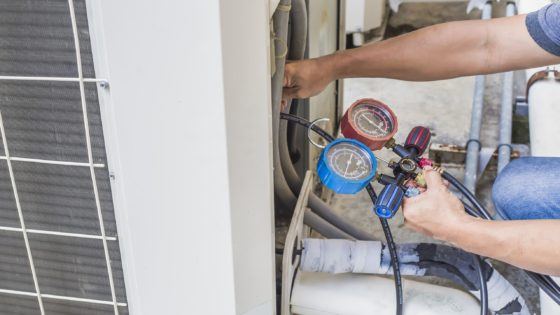
When it’s time to replace your HVAC system, one of the biggest questions is how big of a system you need. It’s tempting to use the advice of friends and family as to the right size and also to save money by going with a smaller unit. However, there are implications for getting the wrong size of unit. Consider why size is so important and what’s used to determine the appropriate size for your home.
What Are BTUs?
The British thermal unit, BTU, is the common measurement of HVAC size. One BTU is equivalent to the amount of heat needed to raise 1 pound of water by 1 degree Fahrenheit.
When it comes to heating systems, this tells you how much heat it’ll put out into your home at one time. The more BTUs it puts out, the more heat it’ll produce when it’s running. For air conditioners, the BTU rating tells you how much heat it’ll absorb from inside your home and transfer outside.
Another term you may see associated with HVAC system size is tons, such as 3-ton air conditioner. Each ton equals 12,000 BTUs, so 3 tons would be 36,000 BTUs.
The Proper Size Isn’t Just About BTUs
While BTUs are the common size discussed for HVAC systems, there is another component important to understand. How much air volume the system can circulate is just as critical as the BTUs. Cubic feet per minute, CFM, is the common measurement for air volume.
If you have a large BTU rating but your system cannot circulate the right amount of air, then it won’t heat or cool your home properly. The circulating fan wheel primary controls the CFM, which is either part of the furnace or air handler. A smaller fan typically circulates less air.
The other component affecting airflow through your system is your ductwork. There has to be enough return vents that are large enough to allow the system to draw the right amount of air.
As you can see, there’s a lot that goes into making sure your system is the right size for your home. If any one of these components doesn’t match the service area properly, then you’ll run into the problems associated with either an oversized or undersized unit.
What Happens With an Oversized Unit?
There are three kinds of issues with an oversized HVAC, including performance, repairs and lifespan. When you have an oversized system, it’ll run heating and cooling cycles that are too short.
Over the winter, an oversized furnace will produce too much heat, triggering the upper limit switch. This turns the burners off until it cools down. However, shortly after it starts up again, it’ll just shut back down, never bringing your home’s temperature to a comfortable level.
When you’re using your air conditioner, an oversized unit will cool your home too quickly, preventing the system from circulating the right amount of air. This leaves you with uneven cooling and a system that runs more cycles than intended. Plus, your system won’t have the opportunity to dehumidify the air, leaving your home feeling muggy.
In both cases, you have a system running shorter cycles more frequently. Starting the cycle puts the most strain on your system, so more cycles compound what your system must endure. The added strain makes system components wear out more quickly, increasing the frequency of repairs, and shortening your system’s service life.
Is Undersized Better?
Undersized systems are equally problematic as oversized ones. Rather than shutting down prematurely, your system will run ceaselessly. Exaggerated utility bills are the obvious implication for long cycles.
However, your components constantly running also wears on them. Just like an oversized unit, you can expect more repairs and that your system won’t reach its intended service age.
Given how important getting the right size unit for your home is, it’s important to understand how it’s calculated. The base calculation is the size of your home in square feet, but there are other contributing factors to consider.
Calculating Your Square Feet
There are three options for determining your home’s size. The simplest is to look at the last real estate listing and see how many square feet it listed.
The problem with this method is it may not consider areas that may be heated but not considered living space, such as a heated garage. It also doesn’t work if you have added to your home since the last real estate listing.
Next, you can simply take the outside measurement of your home and easily calculate the area. Most homes are either square or rectangular, so you simply multiply the width by the length. The issue here is that it doesn’t consider unconditioned areas, such as an attached garage. It also makes it more difficult to account for multiple stories, especially if you have a split-level home.
The third method simply is to go through each room in your home that’s serviced by your HVAC system and calculate the area. Then, you add the areas for all the rooms together, and you have a precise size.
Be sure to account for commonly missed areas like your closets, pantries, guest bathrooms and hallways. Double-check your garage, attic and basement to make sure there aren’t vents in those areas. Even if you have the vents shut to a particular area, you’ll want to account for it when sizing your system.
Converting Square Feet to BTUs
Next, you’ll convert your square feet into the initial BTU measurement. Different areas of the country have different conversion rates based on the needs of the area. Wisconsin is in Climate Zone 5, which requires 50-60 BTUs per square foot.
Therefore, if you have a 3,000 square foot home, your initial need is 150,000-180,00 BTUs. There are several other factors professional installers consider that affect the actual need of your home.
Home Factors
Your home and its construction will certainly influence the size unit you’ll need. The factors in your home include:
- Ceiling height
- Quantity, size, and type of window
- Your insulation
- Heat-producing appliances
- How much shade your home receives
Family Considerations
Beyond those home considerations, you’ll also want to think about your family. Each person produces heat, which is a bonus in the winter and a challenge in the summer. Your installer will account for the normal occupants in your home when determining the size system required.
Be sure you discuss with your installer if you commonly have household occupants who aren’t necessarily family. For instance, consider the implications if you run a business from your home or like to entertain and commonly have groups of people for extended periods. This information becomes very helpful in ensuring your system can keep up with the demand.
For more than 60 years, people around Greenville have turned to Black-Haak for guidance in properly sizing HVAC systems. We proudly offer heating and air conditioning maintenance, repair and installation together with plumbing, electrical, and indoor air quality services. Call to schedule your consultation with one of our expert HVAC installers today.

